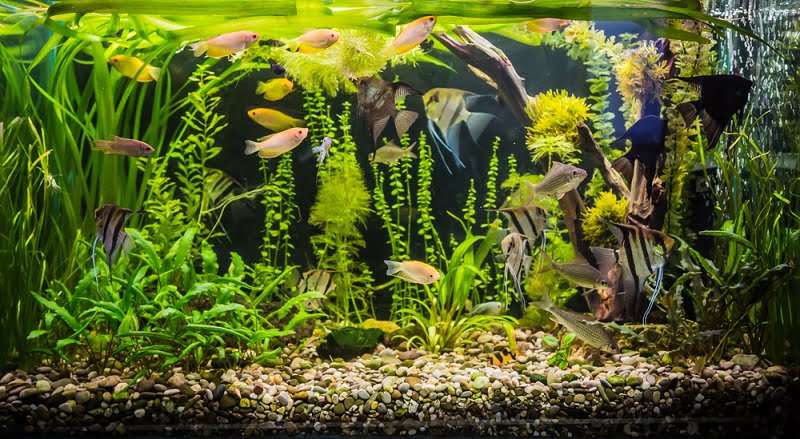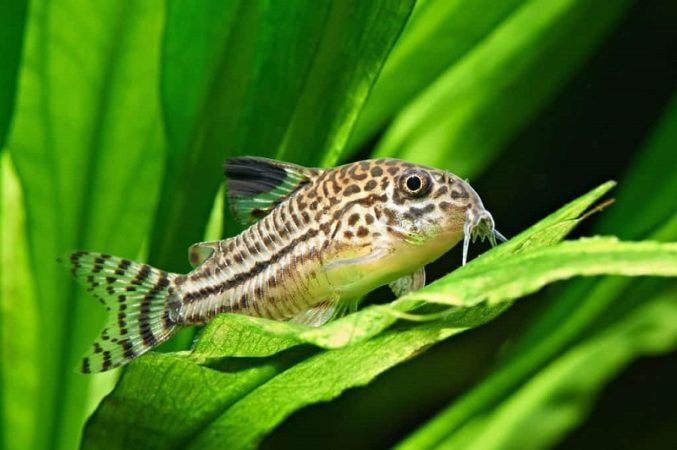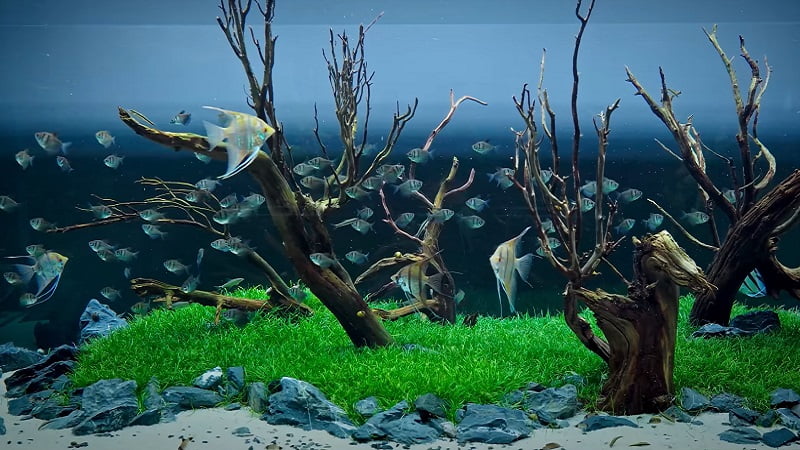Freshwater angelfish are one of the most popular fish in captivity and are a favorite species of many aquarists. Since hobbyists enjoy them so much, they have been captive-bred for many years.
There are many different varieties of angelfish, including gold, black, and koi angelfish, all of which are hardy and quite easy to keep in your home tank.
To help you successfully keep this interesting and beautiful fish, this article will demonstrate crucial and essential information for a basic angelfish tank setup. Let’s get started!
Related Articles
- What’s The Ideal Ph Level For Angelfish? Effects Of Ph Level
- 15 Best Live Plants For An Angelfish Planted Tank (With Pictures)
Angelfish Habitat And Tank Requirements
The natural habitat of freshwater angelfish
Most of the freshwater angelfish species are found in the tropical water of South America, especially in the Amazon River system.
Therefore, in the wild, their habitat is usually slow-flowing or still water, under overhanging leafage, or tree trunks that have fallen into rivers.
Water requirements for freshwater angelfish
Since most of the angelfish come from tropical rivers, they prefer living in slightly warm water in captivity. However, they are hardy fish that can adapt to a wide range of water conditions.
The ideal water parameters for keeping angelfish in the freshwater aquarium are pH of 6.8 – 7.8, the water hardness of 3°-8° dKH (54 -145 ppm), and water temperature of 78-84°F.
Make sure the water is properly filtered and change the water 10% weekly or 25% every two weeks. It is also important to clean the substrate using a vacuum to remove the uneaten food and leaf residues if it is a planted tank.
Suggestions for housing freshwater angelfish
Choosing a suitable tank size for your angelfish. They are quite large species that can reach about 6 – 10 inches when fully grown.
Thus, 55-60 gallons for an angelfish community tank is usually recommended. Besides, they become larger in height than in length, making it better to choose a tall tank rather than the long tank.
According to their natural habitat, they prefer slow-moving water or gentle water currents in their aquarium.
Plants with broad leaves and driftwood arranged vertically to mimic downed branches and trees are also good for emulating their natural habitat. Additionally, some floating plants can be added for shade and cover.
An angelfish will forage along the bottom for food, so the substrate should be fine to medium-grade gravel with a smooth surface.
A Freshwater Angelfish Tank Setup
Angelfish tank setup ideas
As they come from tropical rivers in the Amazon region, there are many ways to build an aquarium for your angelfish tank. They will be happy if the setup is similar to their natural habitat.
Planted tank with plenty of live broadleaf plants, driftwoods, and live rocks can work well. A blackwater biotope is also one of the best choices to copy the wild ponds or rivers in the Amazon. Or you can just go for a simple and inexpensive solution by using live rocks, plastic plants, and a smooth-surface substrate for your fish.
There is a tip to help you build a beautiful angelfish tank. You can add beginner-friendly aquatic plants such as java ferns to your aquarium to help dispose of toxic wastes and add a beautiful touch of nature.

Essential components
- Substrate
The best substrate to start with if you are new to fishkeeping is a simple gravel substrate. Gravel tends to trap a lot of waste, but it can be cleaned easily, and it requires little maintenance.
For the more experienced aquarium owner, using sand substrate in their aquarium can be a beautiful addition. With a sand substrate, your tank will appear more natural and realistic, but it can be harder to clean.
- Lights
If possible, install an aquarium LED light that mimics the sun, and make sure the light is on for eight to twelve hours per day.
- Plants
This depends on which type of angel fish tank setup you want to perform.
If you want a planted aquarium, you can use native plants from the Amazon river, such as Amazon swords and anacharis, to ensure angelfish feel comfortable in the tank. However, it will require more caring actions to ensure good tank quality for your fish.
If you just want a beginner-friendly angelfish tank, you can use fava fern and java moss as they are hardy and easy to care for.
Besides, you can use artificial plants. With artificial plants, you can achieve the look and feel of a naturally planted aquarium with little to no effort. It is best to choose plants that can stand vertically and have large leaves. It will provide a more comfortable habitat for your angelfish as they look similar to the plants found in the Amazon Basin.
To learn more about suitable live plants for your planted angelfish tank, you can read the following article: 15 Best Live Plants For An Angelfish Planted Tank
- Other decorations
Driftwood and rocks are also great aquarium decorations for angelfish tanks.
The habitat of your angelfish can be perfectly recreated with driftwood. In addition, large vertical rocks make an excellent hiding place for fish and an ideal place for them to lay eggs as well.
By providing your angelfish with many hiding spots and decorations that look natural, you can successfully keep them comfortable and stress-free.
Apart from driftwood, you can go with any decoration, provided it doesn’t have sharp edges.
A nylon test will help you determine whether the decoration is rough. Thread a nylon thread along the surface of the decoration; and if you notice snapping nylon, it indicates that the décor has sharp or rough edges.
- Water
You should use quality water when filling your aquarium. A great place to get quality water is your local fish store.
It is important to buy your water from a reputable fish store to ensure that it is free of chlorine and has the correct parameters for your angelfish.
If you want to use tap water, it is a must to use a water conditioner to neutralize the chlorine and to create a safe aquarium for your angelfish. Since tap water contains a lot of chlorides, it can burn the gills of your angelfish and even kill them.
- Tankmates (optional)
If you want to get some friends for your angelfish, try to avoid the fin-nipping species because the angelfish have long and gorgeous fins.
Fast-swimming fish are also bad choices as they will outcompete your angelfish during mealtimes.
Don’t purchase any nano fish or small creatures since your angelfish can eat them when the angelfish grow to a certain larger size.
Some species that can be good friends with your angelfish are black skirt tetras, large cardinal tetras and guppies, and cory catfish.

Crucial steps to set up an angelfish tank
- Determining the location for your angelfish tank
It is important to consider the location of an angelfish aquarium.
The location for placing your angel tank should meet these requirements: close to the power outlet, away from direct sunlight and uncontrolled heat sources, and spacious room for tank maintenance.
You should place it near your home power outlet to avoid using extension cords. You should have enough outlets on one power strip with a reset and breaker.
Safety must always be considered, and the location should ensure that if an electricity leak occurs, the water will not interact with electricity to cause a fire.
Your angelfish tank should not be placed in front of windows because of stimulated algae growth by directed sunlight. In addition, the water temperature will change frequently. For example, on a sunny day, the sunlight may overheat the tank. Such a sudden change in water temperature will make your fish suffer.
Thus, your angelfish aquarium should be located in a quiet location, away from direct sunlight and uncontrolled heat sources. But, bedrooms may not be the ideal choice since the pumps of the tank make a lot of noise.
In addition, the location should be easily accessible for routine maintenance. Your tank’s location should provide enough space for water changes and other routine maintenance.
- Choosing tank stand
Stands for your angelfish tanks should be flat and level. It is best to go for a commercial fish tank stand as it is not only made specifically for aquariums but also matches the decor of the room. But anything with a flat and level surface will be fine for your home aquarium.
- Leveling your angelfish tank
To eliminate irregularities in the tank’s surface, place a flexible plastic or Styrofoam pad between it and the stand. By doing this, you will prevent the pressure from breaking the glass. Make sure the aquarium is level before filling it with decorations and water.
- Setting the substrate
If you plan to utilize an under gravel filter, it should be placed in the tank first. There should be instructions for setting up and assembling the filter included with your purchase. Course-grained gravel is required as fine gravel or sand will clog the filter.
The under-gravel filter, however, does not encourage plant growth. The gravel needs to be nutrient-rich, and thus the gravel designed for plants is advisable. The gravel needs to be at least three inches deep to be able to grow live plants.
The gravel should be washed and placed in the bottom of the tank. Try to grade the gravel in your tank to make it deeper at the back than the front. This will give an illusion of depth.
If you want to create bubbles from the gravel, you can place an air stone under it. When you put it under the gravel, make sure the tube is hooked to it.
- Adding water
Before adding water, you should place rocks, a heater, a filter, aquarium decorations, and ornaments. To keep the aquarium’s landscape intact when pouring water, cover the bottom with newspaper or plastic sheeting. Then pour water on the newspaper, and after the tank has been filled, remove the paper.
- Adding accessories
At this time, you can set up the accessories such as air pumps for the undergravel filter, decoration, and air stones.
A thermometer can be used as a heater for your tank. You can put it on the opposite side of the angelfish tank.
In addition, you can add some water supplements to promote the growth of good bacteria.
Besides, in order to prevent evaporating water from entering the light system of the hood, keep a plastic or glass divider in place.
- Adding your angelfish and tank mates
Allow the aquarium to run for a few days after it has been set up. During this time, you can check the water for pH levels and make sure everything is working correctly.
About a week later, add a few of the fish you selected for the community tank. It is better to introduce the fish to the tank one at a time rather than all at once. After a month of being seasoned, you can add your angelfish to the tank.
Video: Angelfish Tank Setup? Aquarium Care Community
FAQs
Do angelfish need bubblers?
By generating upward-moving bubbles, bubblers can create water movement and turbulence at the surface of the water, increasing the oxygen level in the water.
However, the majority of angelfish do not require bubblers, as they need real filters that create sufficient aeration for them.
What do angelfish like in their tank?
Angelfish prefer warm water with a temperature of about 78 – 84°F with a pH level of 6-7.5. They also like tall heavily planted tanks with various hiding places. And they love to be kept with peaceful tank mates.
Do angelfish need a heater?
An angelfish aquarium’s temperature should be kept between 78 – 84°F (24 – 29°C), so a heating system will probably be required. You can purchase heating systems online or at local pet stores.
Conclusion
In this article, you can find all the essential information for building a suitable and beautiful aquarium for your angelfish.
The angelfish tank setup ideas and requirements are provided with regard to the natural habitat of the angelfish.
Moreover, knowing the wild habitat of the angelfish help determine the appropriate components for your angelfish tank setup, including substrates, vegetation, and other tank decorations.
Remember to maintain good water quality and select suitable tank mates for your angelfish to help them have a comfortable and stress-free environment.

Annette M. Chaney is an experienced marine biologist with over 20 years of experience as an aquarist and fishkeeper. She started her first aquarium at a young age, filling it with frogs and goldfish obtained from the ten-cent pet store.
Annette grew up caring for and breeding African Cichlids, which led to a hobby in high school that doubled as a profitable means. Attending Reed College gave her time to solidify herself as an accomplished aquarium caretaker with an eye for sales. After that, from 2009 – 2013, she studied at Roger Williams University – one of the most prestigious universities for Aquaculture and Aquarium in USA. She is the founder of AquariumCircle since 2010.
